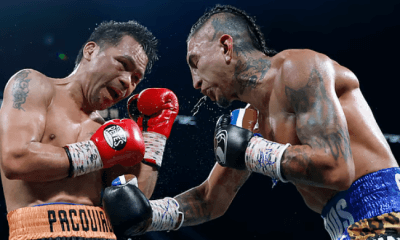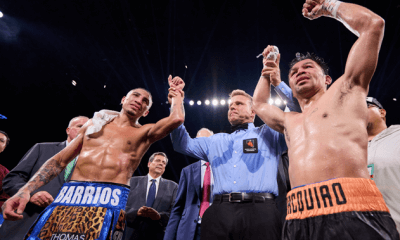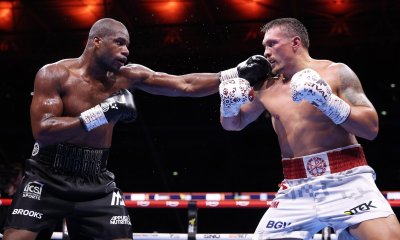Articles
Something To Cheer About…SPRINGS TOLEDO
Erik “El Terrible” Morales hasn't earned significant laurels since he handed Manny Pacquiao his first (and last) defeat on American shores. That was in 2005. Two years later he heard bells in his head after dropping a decision to lightweight titlist David Diaz and promptly retired.
For two and half years he brooded, stuffed his face and brooded some more. Then he drank Tecate and brooded again. His lean frame pushed outwards and reportedly tipped the scales at 200 lbs. His pride, bobbing for air in a sea of frothy calories and depression, did not drown. Eventually it burned again.
It was only the ghost of a former great who took three victories over nondescript opponents last year. And it was, if you asked any number of boxing writers, a man of foolish pride who insisted on facing Marcos Maidana. Maidana, 27, is a natural light welterweight while the aging Morales is a natural featherweight. With reflexes slowed, timing off, balance tenuous, what was Morales asking for in the decision to fight a relentless man considerably bigger and stronger than anyone he had ever faced before? Had this great fighter's destructive impulses reversed direction?
Before the main event Saturday night, Morales shadowboxed in the dressing room. He was bone dry. His arms were no more impressive than an accountant's and his torso had the consistency of a week-old party balloon. In another dressing room Maidana was a study in strength and virility with tattoos splashed all over his musculature like graffiti on a train. One of them was a gun.
Some feared that the responsibility for Morales's impending doom was also our own. What were we asking for when we financed this event, this slaughter? The Morales delusion was unnerving.
Round one hadn't even ended before Maidana landed a hook inside Morales's high guard, causing his right eye to begin closing immediately. Just like that the disadvantages of age and size were compounded by the nightmare of compromised vision. By the end of the third, his eye was sealed shut and he had to fight the next nine rounds as half-blind as Harry Greb, though even Greb had it better than Morales -his handicap was a closely guarded secret while millions saw the condition of Morales's eye in blazing color. His attempts to hide it behind a raised glove were futile; the hard-punching mauler aimed at the tender flesh of the injury and blackened it until it looked like a rotten plum.
In the fifth round, the one good eye of Morales boiled with something like rage. A reanimated right fist came hurling out of the past to strike willful youth, disciplining it and completely changing the narrative of the fight. And with that, the Morales delusion became something else, something grand, something to stand up and cheer about.
Last February, Morales was asked how he beat Pacquiao. He replied that it was due to “something you don't see often, técnica.” Technique. “What's important is technique,” Morales emphasized, “A lot of Mexicans don't look that good physically, but… we know how to fight. It's all about technique. Without a doubt that's the single most important thing for me -technique.” It should be the most important thing for every fighter. There is a nuts and bolts way to deal with any style and technicians carry a tool box. In the preliminaries, Nobuhiro Ishida opened his and quickly exposed the limitations of the puncher James Kirkland, giving Japan something to cheer about. Robert Guerrero's wife is cancer-free, and so, with tragedy averted, he operated like an oncologist on speed against the swarming style of Michael Katsidis. In between the riveting violence of an event billed as “Action Heroes,” boxing was whispering that it is, always was, and ever shall be a thinking man's sport.
When Morales began lifting up Maidana's head with uppercuts to get it in the range of the right cross, wise novices took notes. They watched him jabbing with the authority of a man accustomed to getting his own way, and throwing the “ole one-two” even if it was only a little faster than their grandfathers' mimicry. Straight punches travelled inside eager arcs to prove again and again the supremacy of technical warfare. In the sixth, Morales countered and spun him and unloaded a left hook that wobbled Maidana. The crowd roared. I dropped my drink. At the bell ending round eight, a dazed Maidana wandered around the ring looking for his corner.
Something was happening on the other side of the spectacle. Morales was challenging something beyond flesh, blood, and bone. He was challenging fate. Just before round eleven began, his corner told him that everyone is in favor of his opponent -“even the referee is against you,” they said. They told him that he needed to knock Maidana out to defeat him. They may as well have told him to tilt the earth. He didn't. He couldn't.
“All of us who watched him know now that man cannot beat down Fate, no matter how much his will may flame,” wrote Heywood Broun about another underdog in another time, “but he can rock it back upon its heels when he puts all his heart and shoulders into a blow.” Morales and his tool box were good enough to rock Fate several times on Saturday night. It was thrilling to see. To those who could get on the other side of the violence, it was beautiful to see.
Once again, boxing transcended itself and drew back bloody curtains to reveal that tragedy and glory share the same stage. And we cheered and dropped our drinks because in changing the narrative of this fight, the aging Mexican suggested that we can change our own narratives -our own ultimately dismal expectations- as we contend half-blind against mauling life and marching time. He consoled us.
Erik Morales lost the fight. Fate laughs and tells us that his defeat was inevitable -that our defeat is inevitable. But what matters, damn it all, is not that he lost, but that he “almost won.”
…..
Morales's statements from February 2011 are found in interviews by Elie Seckback and Radio Rahim of Maxboxing.com. “Sport for Art's Sake” was written by Heywood Broun after Georges Carpentier failed in his bid to dethrone Jack Dempsey in 1921. It stands as a source for the essay above as well as an inspiration.
Springs Toledo can be contacted at scalinatella@hotmail.com.
-

 Featured Articles3 weeks ago
Featured Articles3 weeks agoThe Hauser Report: Zayas-Garcia, Pacquiao, Usyk, and the NYSAC
-

 Featured Articles2 weeks ago
Featured Articles2 weeks agoOscar Duarte and Regis Prograis Prevail on an Action-Packed Fight Card in Chicago
-

 Featured Articles2 weeks ago
Featured Articles2 weeks agoThe Hauser Report: Cinematic and Literary Notes
-

 Book Review7 days ago
Book Review7 days agoMark Kriegel’s New Book About Mike Tyson is a Must-Read
-

 Featured Articles4 weeks ago
Featured Articles4 weeks agoManny Pacquiao and Mario Barrios Fight to a Draw; Fundora stops Tim Tszyu
-

 Featured Articles4 weeks ago
Featured Articles4 weeks agoArne’s Almanac: Pacquiao-Barrios Redux
-

 Featured Articles3 weeks ago
Featured Articles3 weeks agoRemembering Dwight Muhammad Qawi (1953-2025) and his Triumphant Return to Prison
-

 Featured Articles4 weeks ago
Featured Articles4 weeks agoOleksandr Usyk Continues to Amaze; KOs Daniel Dubois in 5 One-Sided Rounds















